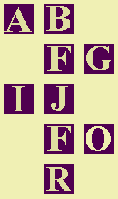For some start configurations, like the induced subgraph of red box graph # 2 shown to the right, we cannot move (with boat size 3 or less). The vertex-edge covering number of that graph is 4.
Still we may work with that game graph, even with boat size 2, but we choose a different start configuration. Now some students are standing on both sides at the very beginning. On the left, some want from left to right, but some want to stay left. The same for the right. Some want to move to the left, and some want to stay right. You can generate them by clicking on "left -----> right", "stays left", "left <----- right", or "stays right". Try the following example:
